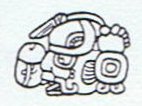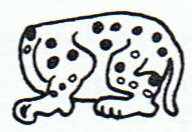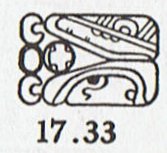|
TRANSLATIONS
We need to use global thinking, not focusing on details. It is irrelevant for our purpose to concentrate on why the souls of the dead inhabit flies in Polynesian but the white flowers of the ceiba tree in America. It is irrelevant to distinguish bees from wasps, too. And the sun creature up in the tree is no real monkey, nor cat, nor kiore, it is a character which climbs - that's enough. A squirrel or a spider will do. Making a collage like this always results in new discoveries and insights. ... I already knew as I stood under the young tree in Tikal that the kings were the human embodiment of the ceiba as the central axis of the world. As I stood there gazing at the flowers in Joyce's hand, I also learned that the kings embodied the ceiba at the moment it flowers to yield the sak-nik-nal, the 'white flowers', that are the souls of human beings. As the trees flowers to reproduce itself, so the kings flowered to reproduce the world ... A great chief stands in the middle like the living tree. He is like the fire in the center of the quincunx. It must be he how is spreading the light and lifting the roof, he will remain forever as a moai after his soul has left. ... However, in common with only a very few of the other Moai, it is believed that these particular statues still have the power, twice a year, to transform themselves into aringa ora - literally 'living faces' - a concept startingly similar to the ancient Egyptian notion that statues became 'living images' (sheshep ankh) after undergoing the ceremony of the 'opening of the mouth and the eyes'. Statues at Angkor were likewise considered to be lifeless until their eyes had been symbolically 'opened' ... Even though H and Q give different messages for the same event, as to darkness giving way for light, the characters run in the same direction - backwards:
I made a quick search in my glyph catalogue and there is no exception to the rule that a 'running person' with outstretched va'e always runs to the left. The closest example showing a 'person' running to the right is Ca9-10:
But here it is more like a moon sign then va'e which is outstretced. I guess the running person with outstretched va'e means 'moving away'. Moon moves in the opposite direction (compared with all the other stars and planets). But in Ha5-27--28 the running seems determined by time (towards the past) rather than space (towards east). In the glyph dictionary my formulations do not cover the running person (only the separate and clear from other signs vae glyph type), but the vae sign carries the same general meaning in the 'running person', it seems:
Now we are prepared to look closer on cab (bee and earth): ... 3. 'The Sky God has also been associated with the month Zec, where an alleged 'sky' glyph alternates with the cab 'earth' glyph. The glyph is certainly very like 'sky' and sometimes seems to occur at Palenque substituting for the regular 'sky' glyph ... According to Landa, this month was dedicated to Hobnil, who was a bee god. Since cab may mean 'bee' as well as 'earth', I suspect that 'bee' is intended here, although Thompson suggests that there may be some connection with the 260-day cycle ...'
I have not until now showed that Kelley has an alternative monument glyph of Tzec:
Can the alternative glyph really illustrate how sky is separating itself from the close embrace of earth? Or is it the face of a bee (cab)? I will tackle this problem now ... The 17th day sign - and I reflect '17 means one more than 16, i.e. waxing moon has left' - is Caban, and the monument glyph of Tzec refers to the Caban glyph type:
"The Maya word cab means earth, world, tierra, the place below, opposed to caan, the sky. The overwhelming evidence on the glyph and its associations in the pictures and texts is for this same meaning, Earth. A most interesting glyph in this connection is one found in Maudslay's Tikal, plate 74, glyph 13, our form 17.33.
The text on the stela shows that this glyph indicates the passage of one day, from 6 Eb, 0 Pop to 7 Eb, 1 Pop; the sun or kin, preceded by the numeral 1, is seen entering between the caban-sign and what we shall later come to identify as the sky-glyph." (Gates) The sky-glyph is leaning, opening up towards left where kin enters. The Maya glyphs are oriented with 'face' towards left (in opposition to the rongorongo glyphs south of the equator). Left means 'future' and right means 'past' in the Maya glyphs. The sky-glyph we recognize from the Tzec monumental glyph:
We should notice the 3 hanging halfcircles in the center and the horizontal beam across (probably the path of the sun from east to west). What presumably is a sun symbol in the center of 17.33 - two concentric circles - is in Tzec more like a short tree stem. Possibly we should discern two 'eyes' at left and right of this 'tree', making the whole look like a face with eyes, nose and a smiling grin. In 17.33 the presumed sun symbol has 3 + 2 straight 'beams' at right and left (3 in the future and 2 in the past). I guess 2 refers to the 'moon season' and 3 to the 'sun season'. "... Among the various local day-names and their meanings we have much confusion, which requires strained argumentation on forced etymological or phonetic grounds, to bring into apparent line. The Nahuatl Ollin means Movement; the Quiché Noh means great or strong; the Zapotec Xoo is said to mean force or power; Chic in Tzeltal has two wholly inapplicable meanings - to burn or scorch, to sweat or ooze out." (Gates) I regard movement as a sign of power, so Ollin, Noh, and Xoo are not far apart in my mind. It is the forceful spring sun which evaporates the water and forces earth and sky apart - moving mountains. It agrees with how the Aztecs regarded this month: '...the Aztecs made sacrifices for 'the birth of the mountains' during their equivalent month, Tepeilhuitl ...' ... Finally, at one time, he could really be heard to enter to them, he, the poor cousin of the Moon, the entrail-snatcher, carrying a dish and a large knife, in order to try to snatch the entrails of the human being. And look! At the window his wife stood and kept on saying: 'She smiles!' The entrail-snatcher began to dance a drum dance, with ridiculous movements, and they only looked at him, while he sang: My little dogs, I get them food, / My little dogs, I get them food, / ha-ahing, ha-ahing, ha-ahing. While he acted thus, his poor wife all along stood at the window saying: 'She smiles, she smiles, she smiles!' She was tremendously busy telling her husband that she smiled. At last she could hardly let be smiling when looking at him, but she placed her hands under the front part of her fur coat and blew violently, as the Moon had told her to do. And indeed he took himself off, the entrail-snatcher, over there, saying: 'One with blubber (i.e., a bear) is heard!' Then he disappeared, and the Moon took his dish and flung it violently into the window platform. There it now lay, while the entrail-snatcher took himself off. When he had taken himself off, it did not last long before he attempted to send for it. 'His dish, it is said, can he have it?' 'He may fetch it himself', said the Moon. 'Let him fetch it himself!' 'His dish, it is said!' Thus they continued for a long time. But when the Moon only kept on saying that he himself should fetch it, then the other one said at last: 'The entrail-snatcher is going to overturn the great mountain, it is said!' But the Moon only answered: 'All right, let him overturn it!' And indeed the other answered: 'All right, it is said, let them only look on!' The great Moon went outside, and there the entrail-snatcher sat, facing the mountain and beginning to move his feet. The large mountain indeed began to move a little. 'Give it him, give it him!' the Moon said at last. 'Give it him, give it him.' Finally he gave it him, and then the entrail-snatcher took himself off for home ... The entrail-snatcher could move mountains, and I have regarded 'the poor cousin of the Moon' as Mercury, i.e. as Zotz. He arrives immediately before sky and earth are ripped apart. "The Yucatec day name Caban corresponds to high-land Maya Noh, to Tzeltal (?) Chic, and to Chuh Kixcab. The element cab means 'earth', and the equivalent Aztec day is called Movement or Earthquake." When the season change mother earth is shaking her 'breasts' = the mountains, of course. The bees have no obviously prominent role in Tzec, they rather indicate the effects of the returning light, they illustrate how the flowers need to be pollinated. One last point to be made: In the month of Tzec summer (sun) enters and moon leaves. There is an opening through which this powerful movement is accomplished, what probably is illustrated as a 'flaring top':  The 16th month, Pax, is the other 'portal', when supposedly moon reenters and sun leaves (the exemplifying glyph according to Gates):  "... Yucatec pax means 'broken, disappeared', and Quiché paxih means, among other things, 'split, divide, break, separate' ..." The 'breaking of the coconut' occurs at new year, we remember. 16 (Pax) - 5 (Tzec) = 11 months à 20 days = 220 days, and 220 days after spring equinox we are some 7 months (of our kind) beyond March 21. Late in October, it seems. sun has to leave and moon reenters. Sun does not seem to leave at once around atumn equinox, according to the Maya. "The patron of Pax is represented by an anthropomorphized feline head, rather resembling the head of the patron of Uo, accompanied by a representation of a paw.  Thompson suggests it may stand for chac mol 'giant paw', a name for the jaguar. He points out that Landa puts a feast to the god Cit Chac Coh 'Geat Father Puma' in this month, but he tends to regard it as coincidental. I am inclined to think that this patron of Pax known from the inscriptions is related somehow to Cit Chac Coh, although no chac glyph appears in the name. Certain similarities to the glyphs of the seventh deity of the Nine Lords of the Night are apparent. They do not amount to identity, and it is not clear whether they refer to the same or a related deity. There are also similarities to the first form of Glyph X of the Lunar Series." 7th deity presumbaly alludes to the day when the week is ending. It is the time of leaving (va'e). The chac mol 'giant paw' is clearly the same concept as the glyph type vae:  There is a headless jaguar picture in Kelley which strengthens the concept of 'breaking the coconut' (or rather of swallowing an 'eye'):  "No one has suggested a plausible meaning or reading for this headless-jaguar glyph." |
|||||||||||||||||









